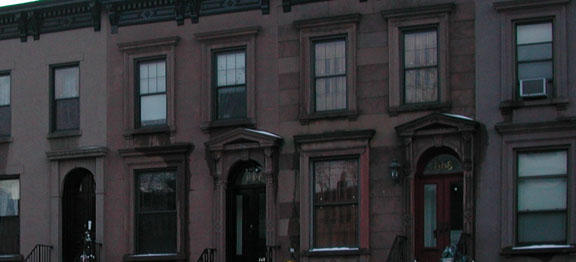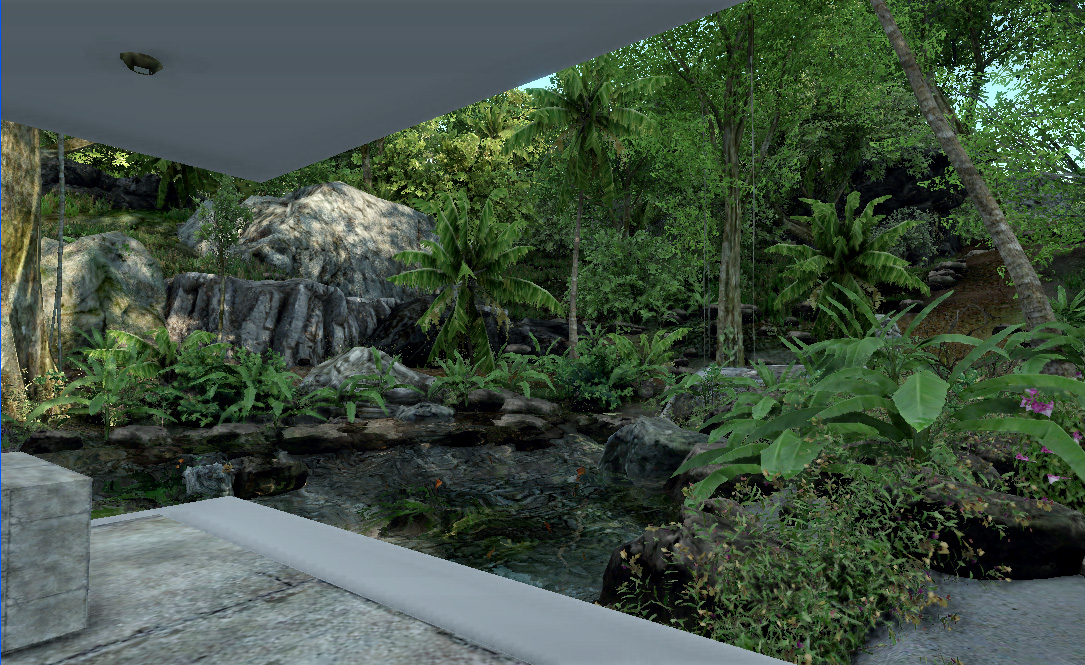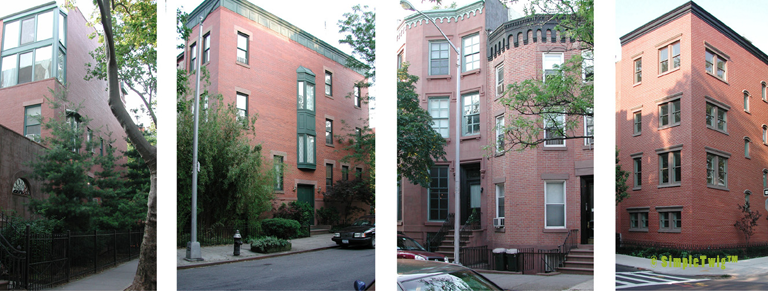The structure of a typical Townhouse chimneys are made up of just a single brick in thickness rising up 3 and 4 stories…
FIVE more THINGS about TOWNHOUSES
Here are 5 more things to keep your eye on when owning a Townhouse.
1 Chimneys
The structure of a typical Townhouse chimneys are made up of just a single brick in thickness rising up 3 and 4 stories. Not very much keeping you safe when you consider the fumes passing up through your house. Considering that other masonry walls are at least 8” thick, and that masonry can crack relatively easily, one would expect that chimneys would have at least the same thick walls. Some flues will have a terra-cotta lining inside which helps create a better safety barrier between the flue and the occupants of the house, but given the fact that grout joints crack, there is a real safety issue to consider.

What to do: In all cases we recommend installing a 2 hour stainless steel flue for Boilers, Hot Water Heaters or any other heating system that uses gas or oil. Furthermore, if the brick flue is not being used and doesn’t have a marble mantel or other architectural use, we recommend removing the ‘boxed out’ area of the flue to allow the room itself to be more functional and, to allow joists to connect directly to the parti wall. One should make sure the structure of the flue is actually carried down to the footings and not ‘cantilevered’ in the cellar (to prevent lateral stresses on the parti wall). Finally, one should check the structure of all masonry hearths as these floor areas are many times structurally compromised due to separation between masonry and rough wood framing below the floor.
2 Paint on Masonry
I’ll be blunt, never paint masonry. If you do, the paint will peal off in a couple of years leaving you with a mess. If you buy a painted house, remove the paint when you see signs of peeling or you will be setting yourself up for major masonry problems in the future. The issue is more than just superficial peeling paint. What paint does is seal moisture inside the masonry, and, in the winter season when interior moisture levels are high and water has the tendency of wicking towards the exterior, the water freezes causing the masonry to flake and spall, resulting larger chunks of the finished brick surface of your house to fall off. This in turn allows more moisture to enter the house and increases the danger to your masonry.
What to do: If you need to refinish the masonry surface of your Townhouse, other than repointing and cleaning the brick, use a masonry coating like Thorough-Seal. It is a porous coating available in a variety of colors that allows masonry to breathe.
3 Asbestos & Lead
ASBESTOS: No one wants to run into Asbestos when buying a house because of its hazardous nature and it’s expense to remove. Before you buy a townhouse spend the ±$600 to have an Environmental Lab take samples of various materials to ensure your home does not have that extra expense, and if it turns out to have asbestos, that you are prepared to pay for its removal.
Where to look for Asbestos: Pipe insulation, vinyl composition tiles, brick mortar, plaster, and tar on the roof. Make sure your Environmental Lab tests all these elements and especially the plaster and mortar used between the bricks as these can be expensive to resolve.
LEAD: Lead is yet another hazardous element you are sure to run into when buying an old townhouse.
What to do: Remove all lead paint. That can mean replacing all painted trim. While you’re at it, replace the lead pipe in the street that is supplying your house with drinking water, with a copper one. While it might be safe due to buildup of calcium, do you really want to take the chance that some lead might seep into the water you’re drinking? There’s nothing better than having a house completely free of hazards like these.
4 Brick, Mortar & Footings
Most of the brick townhouses in Brooklyn are built down to the earth with only a piece of stone separating them from ground moisture and the stresses above. These stone ‘footings’ were considered adequate for buildings that were meant to last some 50 years. Over time, as moisture weeps up into the brick from the ground, or finds its way in through the roof, it starts to erode these ‘clay-made’ bricks, thus weakening the structure above. While stone is often used at the front and rear cellar walls, one has to examine the parti walls for any signs of erosion caused by moisture and settling.
Along with this concern one should acknowledge the quality of brick and mortar used in the different walls of a townhouse above the cellar. Typically the front facade has the best brick and mortar work while the rear non-load bearing wall would use the least quality materials. Coupled with the lack of maintenance the rear wall receives, it’s exposure to the elements and potential water issues caused by poor gutter craftsmanship, this rear wall may require special attention to ensure its integrity.
What to look for: Look for cracks in the brick itself from one course to another. Examine the cellar walls, and if made of brick rather than stone, look for signs of moisture, cracking and settling. Also look at door and window lintels/sills for cracks and gaps. Ask these questions: Does the mortar between the bricks rub off? Has the brick been painted? Is there spalling (flaking of both the paint and brick surface)?
What to do: For footings that are settling, there are a couple of things one can do like underpin the foundation wall, that is, dig out (by a professional) small sections of about 3 feet in length and pour high compression concrete into the hole to make a new footing, and continue the process around the perimeter until you have a continuous new footing. Another way is to remove bricks at the bottom of the foundation wall and add a new reinforced footing that way, but here one has to account for the neighbors interior space… cooperation is key but if you’re having a settling problem they probably are too. In both cases the joists above should be temporarily supported while this work is completed.
5 Joists
Joists are an important part of your Townhouse’s structure. They tie each Parti-Wall together, hold the floors at the right height and allow your stairs to connect the different levels. But there is a major issue with existing townhouse joist design and that is, it is inadequate. Now, when you ask for an opinion from a Structural Engineer, they’ll tell you the joists are fine, that they’ve worked for many decades, but if you push them a bit by asking if they would design a new house with the same sizes and layout as what is in an old Townhouse, they would say no. Here are the issues with existing joists layout:
1) They are undersized and of poor quality (knots, splits, raw);
2) The spacing is spread out too far with little or no cross-bracing. They should be spaced 16” O.C.;
3) The transfer joists are undersized. They should be at least 2 joists in thickness;
4) Some joists are cut in half to accommodate roof hatches, pipes, etc.;
5) Joists are often rotted at the ends or eaten by termites, weakening their strength;
6) The bearing wall is typically under structured or has poor footings;
7) Despite the extra load of transfer beams, the footings under these points are inadequate;
8) Connections to the front and rear masonry walls are inadequate or missing completely;
9) Some joists might be split due to sagging beyond their breaking point, significantly reducing their load carrying capacity.
10) Generations of new roof coatings have created extra loads the roof joists weren’t meant to carry.
What to do: If considering a gut renovation, be sure to address all these issues. Most are easily corrected with replacement or reinforcement. Add additional joists to strengthen transfer joists. Make sure the foundations can handle crucial areas of weight, especially the corners and around chimneys and stairs. Replace any joists that are damaged or split. Reinforce the interior bearing wall.
Conclusion
These are just a few of the most important issues of townhouse ownership which can affect its longevity. Owning a townhouse is probably one’s greatest investment, but considering that old standards of structure and construction were inadequate and questionable, it is reasonable to expect additional repairs to ensure its health. While this is only the tip of what one needs to consider, it certainly sums up the most important structural issues one can encounter.
Townhouses are a unique architectural animal with one of the biggest issues being money. Considering they are built in highly dense areas and land prices are typically high, it can be hard to justify spending money on the ‘hidden’ components of the house, but keep this in mind, if any ‘hidden component’ fails, it will be seen and ruin any work you’ve done for the interior. A smart rule to follow is ‘ensure that the infrastructure is solid before applying the finish’. With this, you’ll be in great shape for decades to come.
And need I say, having a great Architect will help ensure that everything is considered and built correctly the first time.
Other issues not covered in this outline: Cornice, termite prevention, air-infiltration, quality insulation, proper flashing, skylight construction, proper ventilation including removing of ‘heavy air’, security and safety issues, privacy, quality light and cross-ventilation, and spatial organization and plan efficiency.
Note: Only licensed professionals should attempt these suggested corrections.
Prepared by:
SimpleTwig Architecture
Nicholas Joel Buccalo, Architect

